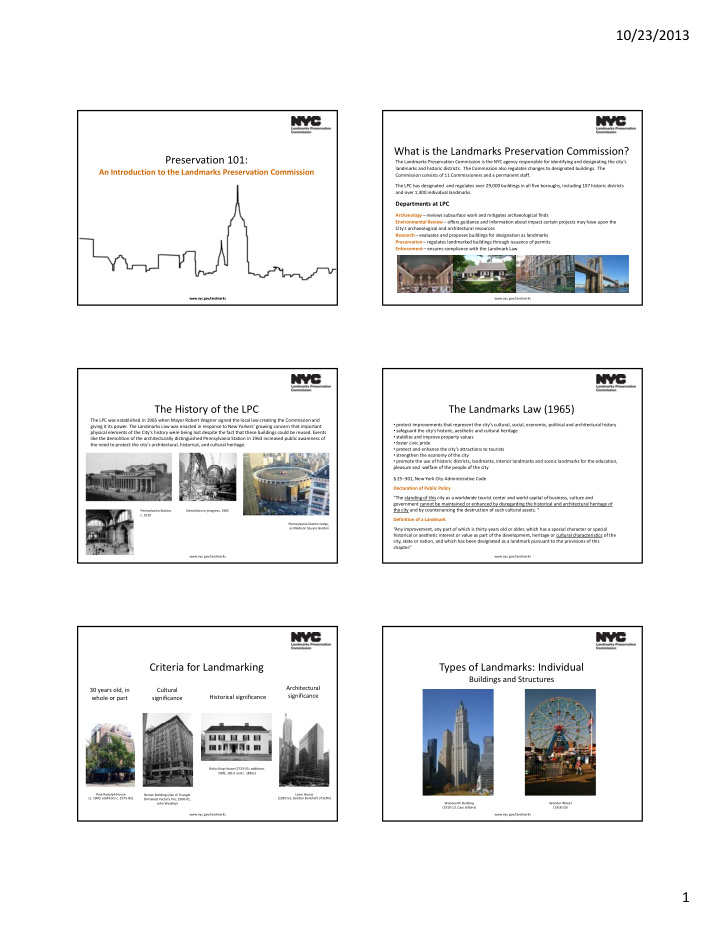



10/23/2013 What is the Landmarks Preservation Commission? Preservation 101: The Landmarks Preservation Commission is the NYC agency responsible for identifying and designating the city’s landmarks and historic districts. The Commission also regulates changes to designated buildings. The An Introduction to the Landmarks Preservation Commission Commission consists of 11 Commissioners and a permanent staff. The LPC has designated and regulates over 29,000 buildings in all five boroughs, including 107 historic districts and over 1,400 individual landmarks. Departments at LPC Archaeology – reviews subsurface work and mitigates archaeological finds Environmental Review – offers guidance and information about impact certain projects may have upon the City’s archaeological and architectural resources Research – evaluates and proposes buildings for designation as landmarks Preservation – regulates landmarked buildings through issuance of permits Enforcement – ensures compliance with the Landmark Law www.nyc.gov/landmarks www.nyc.gov/landmarks www.nyc.gov/landmarks The History of the LPC The Landmarks Law (1965) The LPC was established in 1965 when Mayor Robert Wagner signed the local law creating the Commission and • protect improvements that represent the city’s cultural, social, economic, political and architectural history giving it its power. The Landmarks Law was enacted in response to New Yorkers' growing concern that important • safeguard the city’s historic, aesthetic and cultural heritage physical elements of the City's history were being lost despite the fact that these buildings could be reused. Events • stabilize and improve property values like the demolition of the architecturally distinguished Pennsylvania Station in 1963 increased public awareness of • foster civic pride the need to protect the city's architectural, historical, and cultural heritage. • protect and enhance the city’s attractions to tourists • strengthen the economy of the city • promote the use of historic districts, landmarks, interior landmarks and scenic landmarks for the education, pleasure and welfare of the people of the city l d lf f h l f h i § 25–301, New York City Administrative Code Declaration of Public Policy “The standing of this city as a worldwide tourist center and world capital of business, culture and government cannot be maintained or enhanced by disregarding the historical and architectural heritage of the city and by countenancing the destruction of such cultural assets. “ Pennsylvania Station, Demolition in progress, 1963 c. 1910 Definition of a Landmark Pennsylvania Station today, as Madison Square Garden “Any improvement, any part of which is thirty years old or older, which has a special character or special historical or aesthetic interest or value as part of the development, heritage or cultural characteristics of the city, state or nation, and which has been designated as a landmark pursuant to the provisions of this chapter.” www.nyc.gov/landmarks www.nyc.gov/landmarks Criteria for Landmarking Types of Landmarks: Individual Buildings and Structures Architectural 30 years old, in Cultural significance Historical significance whole or part significance Rufus King House (1733 ‐ 55; additions 1806, 1810, and c. 1830s) Paul Rudolph House Lever House Brown Building (site of Triangle (c. 1900; additions c. 1975 ‐ 82) Shirtwaist Factory fire; 1900 ‐ 01, (1950 ‐ 52, Gordon Bunshaft of SOM) John Woolley) Woolworth Building Wonder Wheel (1910 ‐ 13, Cass Gilbert) (1918 ‐ 20) www.nyc.gov/landmarks www.nyc.gov/landmarks 1
10/23/2013 Types of Landmarks: Historic Districts Types of Landmarks: Interior Areas with a Unique ‘Sense of Place’ Customarily Open to the Public SoHo ‐ Cast Iron Addisleigh Park Prospect Heights (Designated 1973) (Designated 2011) (Designated 2009) Grand Central Terminal Loew’s Paradise Theater (1903 ‐ 13, Reed & Stem and Warren & Wetmore) (1928 ‐ 29, John Eberson) www.nyc.gov/landmarks www.nyc.gov/landmarks Types of Landmarks: Scenic The Path to Designation City ‐ Owned Public Spaces The Process 1. Request for Evaluation 2. Review for Eligibility 3. Calendaring and Public Hearing 4. Designation Report 4 D i i R 5. Commissioners Vote to Designate 6. City Planning and City Council Central Park Morningside Park (Designed 1858, Olmsted & Vaux) (Designed 1873 & 1887, Olmsted & Vaux) www.nyc.gov/landmarks www.nyc.gov/landmarks Performing Work on a Designated Property What are the LPC’s Rules? Title 63 When is approval required? The Landmarks Preservation Commission must approve in The Commission has established Rules and Regulations that allow advance all work affecting an individually designated building or Commission staff to issue permits for various frequent work types any property within an historic district; including any restoration, such as; HVAC equipment, awnings, window replacement, masonry alteration, reconstruction, demolition or new construction. repair, and signage. These Rules allow for staff ‐ level review and p , g g The Commission has adopted rules that authorize the staff to approval of work that meets certain criteria. issue permits for certain types of work. If your proposal meets the criteria set forth in the rules, the staff will issue a permit. Ninety to 95% of applications are approved at staff level pursuant to the Commission rules. The Commission’s Rules and the Landmarks Law are included in the If the proposed work does not qualify for a staff permit, the Charter, Administrative Code, and Rules of the City of New York, and proposal may be presented at a public hearing for approval by the available for download on our website. full Commission. When is approval NOT required? No permit is necessary for ordinary maintenance or for interior alterations that do NOT require a DOB permit. It is always best to call LPC if you are unsure whether you need a permit. www.nyc.gov/landmarks www.nyc.gov/landmarks 2
Recommend
More recommend